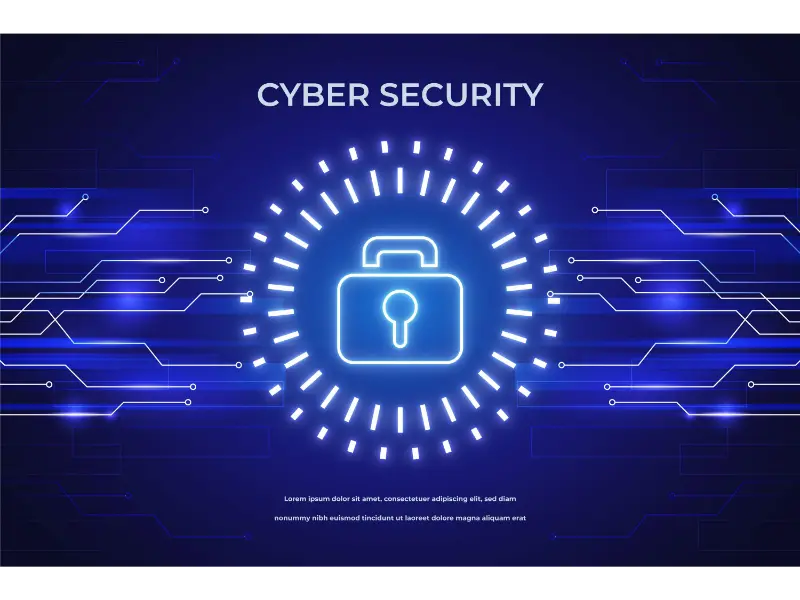In today’s digital landscape, the internet serves as the backbone of almost every aspect of modern life. Websites are crucial tools for businesses, personal branding, e-commerce, and communication. However, with the growing reliance on the web, there has also been a rise in cyber threats targeting websites of all sizes. As a result, cybersecurity has become a fundamental concern in web design.
Designing websites with security in mind is no longer optional—it’s a critical necessity. This article will explore the importance of cybersecurity in web design, common threats to websites, and how you can implement security best practices to protect your site. By the end, you’ll have a solid understanding of what steps to take to secure your website and enhance user trust.
1. The Importance of Cybersecurity in Web Design
At its core, cybersecurity in web design involves integrating protective measures that safeguard a website’s data and user interactions from malicious activities. When creating a website, designers and developers must consider security from the very beginning of the process, rather than treating it as an afterthought. Without sufficient security protocols, websites are vulnerable to hacking, data breaches, malware, and other malicious attacks that can harm users and damage a business’s reputation.
Why Cybersecurity Matters:
Data Protection: Websites collect and store sensitive information such as personal data, financial records, and login credentials. Ensuring that this information is kept safe from unauthorized access is paramount to maintaining user trust and avoiding legal ramifications.
Preserving Brand Trust: A secure website signals to users that you prioritize their safety. When a website suffers a breach or a hacking incident, it can significantly damage its reputation. Restoring consumer confidence can take a long time, and in some cases, the damage is irreparable.
Compliance with Legal Requirements: Various laws and regulations, such as the General Data Protection Regulation (GDPR) in Europe, require websites to take certain steps to protect user data. Failing to comply with these regulations can lead to heavy fines and penalties.
Preventing Financial Loss: Data breaches and cyberattacks can lead to significant financial loss, either through direct theft, fines, or the cost of rebuilding a compromised site. Preventative cybersecurity measures can save a business from costly disruptions.
2. Common Cybersecurity Threats in Web Design
To understand how to defend your website against attacks, it’s important to know the most common cybersecurity threats. These threats target different aspects of a website, from its codebase to its database, and exploit vulnerabilities to gain unauthorized access or disrupt services.
2.1. Malware and Ransomware
Malware: Malicious software designed to infiltrate and damage websites, malware can take many forms, including viruses, trojans, and worms. Once injected into a website’s code, malware can steal data, corrupt files, or even render the site inoperable.
Ransomware: This is a specific type of malware where hackers lock the owner out of their website or database and demand payment to restore access. Failure to pay may result in the permanent loss of data or access to the website.
2.2. SQL Injection
SQL (Structured Query Language) injection is a technique used by attackers to exploit vulnerabilities in a website’s database by inserting malicious SQL code. This can allow them to view, modify, or delete database content, leading to severe breaches such as the exposure of user information, passwords, and financial data.
2.3. Cross-Site Scripting (XSS)
Cross-Site Scripting occurs when attackers inject malicious scripts into a trusted website, which are then executed in the browser of the site’s users. This can result in users’ data being stolen, including session cookies or personal information, or attackers gaining control over users’ accounts.
2.4. DDoS (Distributed Denial of Service) Attacks
A DDoS attack involves overwhelming a website’s server with an enormous amount of traffic, effectively shutting it down and making it inaccessible to legitimate users. DDoS attacks can cripple websites for hours or even days, causing significant financial losses and reputational damage.
2.5. Phishing
Phishing attacks often involve creating fake websites that appear identical to legitimate ones, tricking users into providing sensitive information such as login credentials or credit card numbers. These attacks often target websites with significant user bases, such as e-commerce platforms.
2.6. Brute Force Attacks
In a brute force attack, hackers use automated tools to try multiple username and password combinations until they guess the correct one. This type of attack targets poorly secured login systems, especially those with weak or default passwords.
2.7. Zero-Day Vulnerabilities
A zero-day vulnerability is a security flaw in software that is unknown to the vendor and has not yet been patched. Hackers exploit these vulnerabilities before developers can issue fixes, potentially leading to widespread damage.
3. Best Practices for Implementing Cybersecurity in Web Design
Given the variety of cybersecurity threats that websites face, it’s essential to take a multi-layered approach to security. The following best practices can help designers and developers integrate strong security features into their web design projects.
3.1. Use HTTPS and SSL Encryption
One of the most basic yet critical steps in securing your website is to ensure that it uses HTTPS instead of HTTP. HTTPS encrypts the data transferred between your website and the user’s browser, protecting sensitive information like login credentials and payment details from being intercepted.
- SSL Certificates: Secure Sockets Layer (SSL) certificates are required for HTTPS. Many hosting providers offer SSL certificates, and they should be implemented as a default for all websites, particularly those handling sensitive user data.
- SEO Benefits: Search engines like Google prioritize websites that use HTTPS, so securing your site can also improve your search engine rankings.
3.2. Secure User Authentication
Strong user authentication protocols are critical for protecting websites from unauthorized access. Simple username-password combinations are often not enough.
Strong Passwords: Enforce strong password policies by requiring users to create passwords that include a combination of upper and lower case letters, numbers, and special characters.
Two-Factor Authentication (2FA): Two-factor authentication adds an extra layer of security by requiring users to provide two forms of identification, such as a password and a verification code sent to their phone. This makes it significantly harder for hackers to gain unauthorized access.
3.3. Regular Software Updates and Patching
Many security vulnerabilities arise from outdated software or plugins. Hackers are constantly searching for flaws in common content management systems (CMS) like WordPress, Joomla, or Drupal. Keeping your website’s software up to date ensures that known vulnerabilities are patched.
Update CMS Platforms: Regularly check for updates to your CMS platform and any associated plugins or themes.
Use Reputable Plugins: Avoid installing unverified or little-known plugins, as they may introduce security risks. Only use plugins from trusted developers and ensure they are regularly maintained.
3.4. Implement Web Application Firewalls (WAF)
A web application firewall is a security system that monitors and filters incoming HTTP requests to your site, blocking malicious traffic before it can reach your web server.
Cloud-Based WAFs: Cloud-based WAFs, such as those offered by services like Cloudflare or Sucuri, provide an added layer of security and can help protect against DDoS attacks, SQL injections, and XSS vulnerabilities.
Rule-Based Protection: WAFs can be configured to block requests based on specific rules, such as requests from known malicious IP addresses or suspicious patterns in URL queries.
3.5. Sanitize User Input
One of the most common ways hackers exploit websites is through unsanitized input fields. Any form field, such as login forms, search bars, or comment sections, can be a potential entry point for malicious code if not properly sanitized.
Validation and Escaping: Always validate and escape user inputs to prevent SQL injection and cross-site scripting attacks. Ensure that special characters, like quotation marks or semicolons, are removed or neutralized before processing inputs.
Limit Input Length: Restrict the length of input fields to reduce the likelihood of a successful injection attack.
3.6. Backup Your Website Regularly
Regular backups are an essential part of website security. In the event of a cyberattack or data loss, having a recent backup of your site allows you to restore functionality quickly without losing critical data.
Automated Backups: Many web hosting providers offer automated backup solutions, but it’s important to ensure that backups are stored securely and offsite (in case your hosting server is compromised).
Version Control: Implement version control systems that allow you to restore your website to a previous version, minimizing downtime after a security breach.
3.7. Monitor and Audit Website Activity
Monitoring your website for suspicious activity can help detect cyberattacks early and prevent them from causing significant damage.
Security Logs: Enable security logging on your site to track login attempts, file changes, and database queries. Review these logs regularly to identify any unusual activity.
Intrusion Detection Systems (IDS): Consider using an IDS to monitor traffic and alert you if a potential threat is detected. Some tools, like Sucuri or Wordfence (for WordPress), offer built-in monitoring systems to track real-time security risks.
3.8. Educate Your Team and Users
Cybersecurity is not solely the responsibility of developers—it’s a shared responsibility between all stakeholders, including designers, content creators, and users.
Employee Training: Ensure that all employees or team members involved in the website’s maintenance are educated about cybersecurity best practices, such as recognizing phishing emails or avoiding suspicious links.
User Security Awareness: Encourage your website users to adopt secure habits, such as using strong passwords and enabling two-factor authentication.
4. Advanced Cybersecurity Techniques for Enhanced Protection
While the best practices outlined above provide a strong foundation for website security, there are also more advanced techniques that can be implemented to further enhance protection.
4.1. Content Security Policy (CSP)
A Content Security Policy (CSP) is a security measure that helps prevent cross-site scripting attacks by specifying which sources of content are allowed to be loaded on a webpage.
- Script Whitelisting: With CSP, you can whitelist trusted sources for scripts, images, stylesheets, and other types of content, blocking any unauthorized or malicious content from being executed on your site.
4.2. Server-Side Security
While many security measures focus on the front end of web design, securing the server that hosts your website is just as important.
Server Configuration: Ensure that your server is configured to block unauthorized access. This can include disabling unnecessary services or limiting access to sensitive files.
Secure Hosting Providers: Choose a web hosting provider that prioritizes security and offers features like DDoS protection, firewall configurations, and automatic backups.
4.3. Secure File Uploads
If your website allows users to upload files (e.g., images, PDFs), ensure that these files are properly screened to prevent malicious content from being uploaded.
File Type Restrictions: Limit the types of files that can be uploaded and ensure that uploaded files are scanned for malware.
Isolated Upload Directories: Store uploaded files in isolated directories with restricted permissions to prevent unauthorized access.
Cybersecurity in web design is an essential aspect that cannot be overlooked. By understanding the common threats and implementing security best practices, you can safeguard your website against malicious attacks, protect user data, and maintain the integrity of your online presence. From securing authentication methods to using SSL encryption and regularly updating software, these proactive measures ensure that your website remains a safe and trusted platform for users. As cyber threats continue to evolve, staying informed and vigilant will be your best defense.








